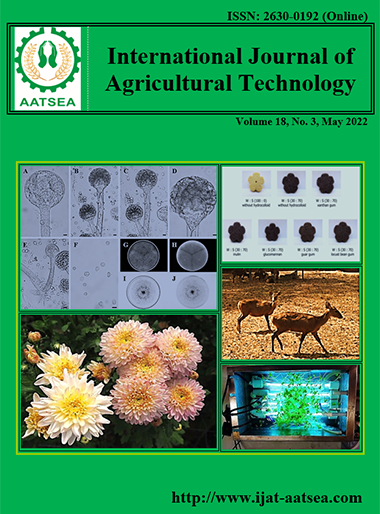Morphological and physiological characterization of four soybean varieties with different drought stress
Main Article Content
Abstract
The experiment reported the morphological and physiological response of soybean varieties grown under different field capacity in sandy soil. Results indicated there was an interaction between soybean varieties and field capacity on days to flowering. Soybean varieties affect on plant height height (2 and 4 WAP), number of leaves (6 WAP), number of flowers, days to flowering, leaf greenness, leaf area index, number of stomata, number of openned stomata and stomata density. Meanwhile, field capacity influenced the number of leaves (4 and 6 WAP), number of branches (4 and 6 WAP), leaf area, number of flowers, days to flowering, leaf area index and seed weight per plant. Grobogan variety had the fastest flowering time (26 days after planting). In adiition, there were no significant differences among the soybean varieties in terms of seed weight per plant. Soybean grown in 100, 75 and 50 % FC had the highest seed weight per plant, while soybean grown in 25% FC had the lowest seed weight per plant. In conclusion, morphologically effects of drought stress of soybean took place when soybean grown at 50% FC and lower. Meanwhile, physiological responses of soybean to different in FC were resulted from changes in stomata density
Article Details

This work is licensed under a Creative Commons Attribution-NonCommercial-NoDerivatives 4.0 International License.
References
Aboyami, Y. A. (2008). Comparative growth and grain yield responses of early and late soybean maturity group to induced soil moisture stress at different growth stages. World Journal of Agricultural Sciences, 4:71-78.
Adisarwanto (2006). Budidaya Dengan Pemupukan Yang Efektif dan Pengoptimalan Peran Bintil Akar Kedelai. Penebar Swadaya. Jakarta.
AFSIS (Asean Food Security Information System) (2016). Asian Agricultural commodity outlook. AFSIS Secretariat OAE Ministry of Agriculture and Coooperatives. Bangkok (17 December 2016). Retried form http://www.aptfsis.org.
Asyura, L. A. G., Hasanah, Y. and Irmansyah, T. (2018). Grwoth and production response of soybean (Glycine max (L.) Merrill) against drought stress treatment and provisions of antioxidants salicylic acid and ascorbic acid. Jurnal Agroekoteknologi FP USU, 6:174-179.
Balitkabi (Balai Penelitian Tanaman Aneka Kacang dan Umbi) (2013). Info Teknologi » Dering 1, Varietas Kedelai Toleran Kekeringan pada Fase Reproduktif. Retried from http://balitkabi.litbang.pertanian.go.id/infotek/dering-1varietas-unggul-kedelai-toleran-cekaman-kekeringan-selama-fase-reproduktif/.
Balitkabi (Balai Penelitian Tanaman Aneka Kacang dan Umbi) (2016). Varietas Unggul kedelai.
Banziger, M., Edmeades, GO., Beck, D. and Bellon, M. (2000). Breeding for Drought and Nitrogen Stress Tolerance in Maize: From Theory to Practice. CIMMYT. Mexico.
Chun, H. C., Lee, B., Gong, Y. D. and Jung, K. Y. (2021). Efffects of droughts sress on root morphology and spatial distribution of soybean and adzuki bean. Jurnal of Integrative Agriculture, 20:2639-2651.
Hamim (2007). Fisiologi Tumbuhan. Jakarta (ID): Universitas Terbuka.
Hartman, G. L., West, E. D. and Herman, T. K. (2011). Crops that feed the World 2. Soybean-worldwide production. use. and constraints caused by pathogens and pests. Food Security, 3:5-17.
Kementan, R. I. (2020a). Keputusan Kementerian Pertanian Republik Indonesia No. 852/HIK.540/C/06/2020 Tentang Pelepasan calon varietas kedelai 19 BE sebagai varietas unggul dengan nama Devatra 1.
Kementan, R. I. (2020b). Keputusan Kementerian Pertanian Republik Indonesia No. 853/HIK.540/C/06/2020 Tentang Pelepasan calon varietas kedelai 19 BE sebagai varietas unggul dengan nama Devatra 2.
Kusvuran, S. (2012). Influence of drought stress on growth. ion accumulation and anti-oxidative enzymes in okragenotypes. International Journal of Agriculture and Biology, 14:401-406.
Pambudi, S. (2013). Budidaya dan Khasiat Kedelai. Yogyakarta. Pustaka Baru Press.
Purwanto and Agustono, T. (2010). Kajian fisiologi tanaman kedelai pada kondisi cekaman kekeringan dan berbagai kepadatan gulma teki. Agrosains, 12:24-28.
Seversike, T. M. (2011). Drought Tolerance Mechanisms in Cultivated and Wild Soybean Species. A dissertationsubmitted to the Graduate Faculty of North CarolinaState University in partial fulfillment of the requirementsfor the degree of Doctor of Philosophy.
Sinay, H. (2015). Pengaruh Perlakuan Cekaman Kekeringan Terhadap Pertumbuhan dan Kadungan Prolin pada Fase Vegetatif Beberapa Kultivar Jagung Lokal dari Pulau Kisar Maluku di Rumah Kaca. Prosiding Seminar Nasional Pendidikan Biologi 2015. yang diselenggarakan oleh Prodi Pendidikan Biologi FKIP Universitas Muhammadiyah Malang (ID).
Srivastava, M. L. (2002). Plant Growth and Development. Hormone and environment. California (US): Academic Press
Sulistyono, E., Suwarno and Lubis, I. (2011). Karakterisasi morfologi dan fisiologi untuk mendapatkan marka morfologi dan fisiologi padi sawah tahan kekeringan (- 30 kPa) dan produktivitas tinggi (> 8 t/ha). Agrovigor, 6:92-102.
Suyamto and Soegiyatni (2002). Evaluasi toleransi galurgalur kedelai terhadap kekeringan. Dalam:ProsidingTeknologi Inovatif Tanaman Kacang-kacangan danUmbi-umbian Mendukung Ketahanan Pangan. Pusat Penelitian dan Pengembangan Tanaman Pangan.hal 218 -224. Malang.
Taiz, L. and Zeiger, E. (2006). Plant Physiology. 3th ed. Sounderland (GB): Sinauer associates Inc. Publisher.
Wirnas, D., Widodo, I., Sobir, Trikoesoemaningtyas and Sopandie, D. (2006). Pemilihan Karakter Agronomi untuk Menyusun Indeks Seleksi pada 11 Populasi Kedelai Generasi F6. Jurnal Agronomi Indonesia, 34:19-24.
Zang, Z. and Lu, C. (2020). Clustering analysis of soybean to understand its spatiotemporal dynamics in the north China plain. Sustainability, 12 (6178).


